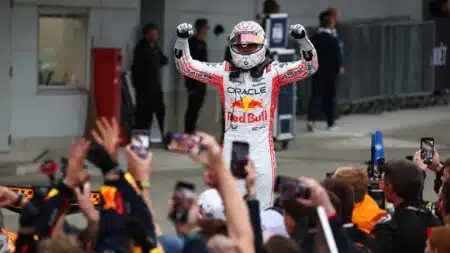
F1 snore-fest shows new cars badly needed: Up/Down Japanese GP
The 2025 Japanese GP showed a much more extreme change than next year's technical regulations is needed to make racing at classic F1 tracks interesting
The last time I saw Carroll Shelby was at the Los Angeles Auto Show in the autumn. He was there to unveil the latest car to bear his name. When asked what he thought of it, he replied “I’ve always been asked, ‘What is your favourite car?’ and I’ve always replied, ‘The next one’. Well, I’m taking that back tonight. This is my favourite car.”
Even before I drove the Shelby Mustang GT500, it wasn’t hard to see why. The following sentence is worth considering for a moment: it has more power than a McLaren F1 or any Ferrari that’s ever gone on sale, but at a UK equivalent price of £34,500, it costs less than a top of the range Vauxhall Insignia.
It got that way by taking the engine from the Ford GT, expanding it to 5.8-litres and turning the screw on its supercharger still further. Everything else – brakes, steering, tyres, diff, gear ratios and suspension – is uprated to cope.
I came across it in the Goodwood FoSTec pavilion, though what ground-breaking technology brought it there eludes me: if ever there were an old school bruiser, a car that directs 662bhp to the tarmac through the medium of a live rear axle, this is surely it.
It was the only Shelby in the country and was due to leave Goodwood straight after the Festival, but far from wanting me to gently ease my way up the hill, Ford requested quite the reverse, “we’ve only got it for the weekend and it’s important we show what it can do,” said its custodian before kindly showing me how to disarm all the traction and stability programmes. “The last person in this car left black lines 100 yards long,” I was told, “we’re expecting rather more from you.”
I don’t know how far it is from the start of the hillclimb to the braking point for the first corner, but I do know that it was only when my foot lifted from the accelerator for that corner that the wall of white smoke in my mirror finally cleared. I was, of course, trying to keep the tyres spinning for as long as possible, but the usual cheat of slowing the car with your left foot on the brake while keeping the tyres alight with your right foot was entirely unnecessary.
To be honest it didn’t seem that fast. In fact I was more surprised and therefore impressed by the precision with which the nose turned into the corner. But when I finally open the throttles wide again, two gears higher to make sure the tyres would bite, I was struck by the sensation that if I didn’t lift really rather quickly, we’d soon be in Kent. If it has the traction, this Mustang is preposterously, wildly and wonderfully fast.
For someone who grew up with a probably unhealthy love of late 1960s American muscle cars, the Mustang was all I could have hoped for and about 200bhp more. No doubt had I driven it for more than a single minute I could have found all sorts of issues with it, but in those few flashing moments it knew precisely what was needed. As the last car seen by Carroll Shelby to bear his name it was important to me that it was ridiculously quick, absurdly dramatic and just a little frightening. Sitting slightly wide eyed at the top of the hill watching the smoke settle, I knew how well that job had been done.

The 2025 Japanese GP showed a much more extreme change than next year's technical regulations is needed to make racing at classic F1 tracks interesting

Max Verstappen looks set to be pitched into a hectic, high-stakes battle for F1 victories in 2025, between at least four teams. How will fans react if he resorts to his trademark strongman tactics?

Red Bull has a new team-mate for Max Verstappen in 2025 – punchy F1 firebrand Liam Lawson could finally be the raw racer it needs in the second seat

The 2024 F1 season was one of the wildest every seen, for on-track action and behind-the-scenes intrigue – James Elson predicts how 2025 could go even further